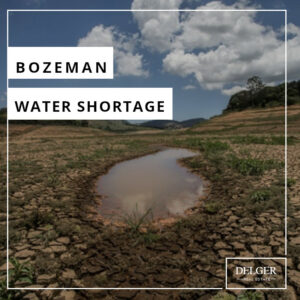Bozeman Water Shortage
 Bozeman could face a water shortage in the coming years, and in July of 2021 Bozeman declared “Stage 2” drought restrictions. There are several factors leading to Bozeman’s Water Shortage including population growth, and climate. Bozeman is the fastest-growing city for its size in the United States according to the U.S. Census Bureau. According to a study about regional water and wastewater infrastructure, long-range population projections show that as many as 450,000 people could reside in the areas in and around Bozeman and Belgrade by 2070. The growth in the population of Bozeman means more demand on water resources.
Bozeman could face a water shortage in the coming years, and in July of 2021 Bozeman declared “Stage 2” drought restrictions. There are several factors leading to Bozeman’s Water Shortage including population growth, and climate. Bozeman is the fastest-growing city for its size in the United States according to the U.S. Census Bureau. According to a study about regional water and wastewater infrastructure, long-range population projections show that as many as 450,000 people could reside in the areas in and around Bozeman and Belgrade by 2070. The growth in the population of Bozeman means more demand on water resources.
Bozeman is also a semi-arid climate averaging only 16 inches of precipitation annually, making the area prone to droughts. Bozeman gets most of its water from the snowpack in the Gallatin Mountain Range. This snowmelt flows down Sourdough Creek, where it then fills Hyalite Reservoir. The Sourdough Creek and Hyalite Reservoir systems account for around 80% of the drinking water for Bozeman residents, while the other 20% comes from Lyman Creek in the Bridger Mountains. With the climate getting warmer, more precipitation will arrive in Bozeman as rain rather than snow. The decrease in the average snowfall will reduce the snowpack, directly affecting the amount of available drinking water. The warmer climate will also affect when snow will melt, potentially causing a water shortage during hot and dry summers.
As a result of this impending water crisis, Bozeman is looking at alternative solutions including using groundwater as an additional water source, and a pipeline from Canyon Ferry Reservoir to the Gallatin Valley.
The plan for using groundwater as an additional source is called the Integrated Water Resources Plan (IWRP), which was created based on data collection and analysis by multiple engineering firms. The plan also advocates for water conservation as the most efficient way to prevent a water shortage in the coming years and as the cheapest, most prudent way of saving water.
Montana uses a system of prior appropriation to determine Bozeman Water Rights, so those whose rights are older get priority when water supply is low. Bozeman is in the Upper Missouri River Basin, which is a closed basin, meaning there are no more water rights to be acquired.
Bozeman could try to acquire existing water rights, but that would be difficult. Instead, the city of Bozeman is planning to establish groundwater wells as an additional water source. A location on the northwest side of Bozeman near Bozeman Sports Park has been identified as a potential site for test wells. Bozeman’s capital improvement plan includes an allocation of $10 Million for the project in 2025. A municipal well project like this will face numerous challenges, including determining how pumping groundwater will impact surface water.
Bozeman represents approximately 45% of the population in Gallatin County, and Gallatin Valley still has significant agricultural use. Agricultural users have some of the oldest Water Rights in Gallatin Valley. Montana Water Rights operates under what is known as the Doctrine of “Prior Appropriation.” This doctrine says that those who first put water to beneficial use get to continue using it first when water is scarce.
A second possible solution being considered — albeit in very early stages of discussion — is a pipeline from Canyon Ferry Reservoir to the Gallatin Valley. Bozeman and Belgrade have about 23,000 acre-feet of water rights between them currently. It is estimated that in 50 years the two cities could need as much as 60,000 acre-feet of water. An acre-feet of water is a measurement of how much water it would take to cover an acre of land in one foot of water depth. 1,000 acre-feet of water serves about 3,500 to 4,000 homes.
Bozeman, Belgrade, and Gallatin County signed an agreement in 2021 committing them to a regional study on additional water and wastewater infrastructure.
Bozeman is also focusing on water conservation to ensure there is enough water in the future. Bozeman offers incentives and rebate programs for people to replace their lawns with more water-tolerant landscaping, and to install water-efficient appliances in their homes.
Stage Two Drought Restrictions may be put in place every year going forward. 50% of Bozeman’s potable water is used for lawn irrigation. Under Stage Two Drought Restrictions residents are restricted to water lawns only 2 days per week. These restrictions resulted in a 20% drop in water usage. In 2022 all Bozeman residents who irrigate using City water are required to adhere to permanent outdoor watering restrictions.
Even though Bozeman’s population more than doubled between 1980 and 2020, overall water use by the city was actually slightly lower in 2020 than it was 40 years ago. The per capita daily water use in 1980 was 291 gallons. In 2020 the average per capita daily water use for Bozeman was 114 gallons.
Even though progress has been made, Bozeman’s Water Shortage will continue to limit how the population growth that Bozeman can sustain, and may impact real estate purchases.
Category : Bozeman Information , Buyer Information

